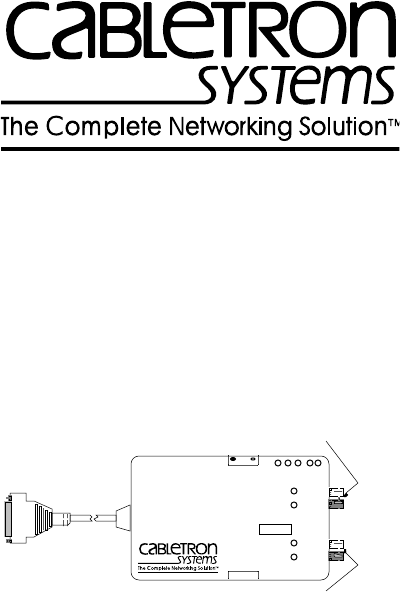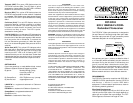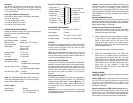
Transmit (XMT)
This green LED flashes when the
FOT-DF24 transmits data. The LED flash is pulse
stretched for viewing effect. The XMT LED is off when
the device is active but not transmitting.
Receive (RCV)
This yellow LED flashes when the
FOT-DF24 receives data from the network. If attached
to a repeater, RCV flashes when data passes through
the FOT-DF24. The LED is pulse-stretched for viewing
effect.
Collision (CLN)
This red LED flashes when the
transceiver detects a collision condition or a jabber
packet on the network. The flash frequency may
increase as network traffic increases since more
collisions are likely to occur. The LED is pulse-
stretched for viewing effect.
Link OK (LNK)
When lit, this green LED indicates that
a link exists between the FOT-DF24 and the device at
the other end of the fiber optic segment. LNK remains
lit as long as the link is maintained. To maintain the
link, the transceiver generates a 1 MHz idle signal
when it is not transmitting data. Both ports can show a
valid link.
Active Port (ACT)
This yellow LED indicates which
fiber optic port is handling all network traffic through
the transceiver. Only one port can be active; the
inactive port ACT LED is off. A flashing ACT LED
indicates that the port is in the idle state. A slow flash
indicates that the time-out period is set to 10 seconds;
a fast flash indicates that the time-out period is set to
2 seconds.
GETTING HELP
If you have questions, or need additional help, contact
Cabletron Systems Technical Support as follows:
By phone: Monday through Friday,
8 am to 8 pm EST at
(603) 332-9400
By CompuServe: GO CTRON from any ! prompt
By Internet mail: support@ctron.com
LANVIEW
is a registered trademark of Cabletron
Systems, Inc.
FOT-DF24
is a trademark of Cabletron Systems, Inc.
CompuServe
is a registered trademark of
CompuServe, Inc.
Ethernet
is a trademark of Xerox Corp.
FCC NOTICE
This device complies with Part 15 of the FCC rules.
Operation is subject to the following two conditions: (1) this
device may not cause harmful interference, and (2) this
device must accept any interference received, including
interference that may cause undesired operation.
NOTE: This equipment has been tested and found to comply
with the limits for a Class A digital device, pursuant to Part 15
of the FCC rules. These limits are designed to provide
reasonable protection against harmful interference when the
equipment is operated in a commercial environment. This
equipment uses, generates, and can radiate radio frequency
energy and if not installed in accordance with the operator’s
manual, may cause harmful interference to radio
communications. Operation of this equipment in a residential
area is likely to cause interference in which case the user will
be required to correct the interference at his own expense.
WARNING:
Changes or modifications made to this device
which are not expressly approved by the party responsible for
compliance could void the user’s authority to operate the
equipment.
DOC NOTICE
This digital apparatus does not exceed the Class A limits for
radio noise emissions from digital apparatus set out in the
Radio Interference Regulations of the Canadian Department
of Communications.
NOTICE
Cabletron Systems reserves the right to make changes in
specifications and other information contained in this
document without prior notice. The reader should in all cases
consult Cabletron Systems to determine whether any such
changes have been made. The hardware, firmware, or
software described in this manual is subject to change
without notice.
IN NO EVENT SHALL CABLETRON SYSTEMS BE LIABLE
FOR ANY INCIDENTAL, INDIRECT, SPECIAL, OR
CONSEQUENTIAL DAMAGES WHATSOEVER
(INCLUDING, BUT NOT LIMITED TO, LOST PROFITS)
ARISING OUT OF OR RELATED TO THIS MANUAL OR
THE INFORMATION CONTAINED IN IT, EVEN IF
CABLETRON SYSTEMS HAS BEEN ADVISED OF, KNOWN
OR SHOULD HAVE KNOWN, THE POSSIBILITY OF SUCH
DAMAGES.
© Copyright August 1994 by
Cabletron Systems, Inc.
P.O. Box 5005, Rochester, NH 03866-5005
All Rights Reserved
Printed in the United States of America
Part number: 9030729-02 August 1994
FOT-DF24
802.3 10BASE-FL/FOIRL
Redundant Transceiver
The FOT-DF24™ fiber optic transceiver is designed to
link two Ethernet™ devices through fiber optic cable.
Dual fiber optic ports with ST type connectors provide
redundant data paths for critical applications.
If the primary port (port 1) receives no data for either 2
or 10 seconds (switch selectable), the port enters the
idle state. During the idle state, if the back-up port
(port 2) receives data it becomes the active port.
When the primary port senses data again, it switches
back to become the active port. The two transceiver
ports can be connected to the same network device,
different network devices or even different networks.
REQUIREMENTS
The FOT-DF24 Transceiver complies with IEEE 802.3
10BASE-FL/FOIRL specifications. Use the FOT-DF24
with Version 1, Version 2, and/or IEEE 802.3
equipment. For best network performance, observe
the following network guidelines.
Fiber Optic Requirements
The FOT-DF24 supports 50/125
µ
m, 62.5/125
µ
m, and
100/140
µ
m fiber optic cable. Link length depends on
cable type and system fiber optic budget. The FOT-
DF24 supports a maximum link length of 2 km.
FOT-DF24
802.3 10BASE-FL/FOIRL
REDUNDANT TRANSCEIVER
WITH LANVIEW®
P
W
R
S
Q
E
X
M
T
R
V
C
C
L
N
SN
LNK
ACT
TX
RX
LNK
ACT
TX
RX
MIN MAX
SQE
Primary Port
Back-up Port
1
2




